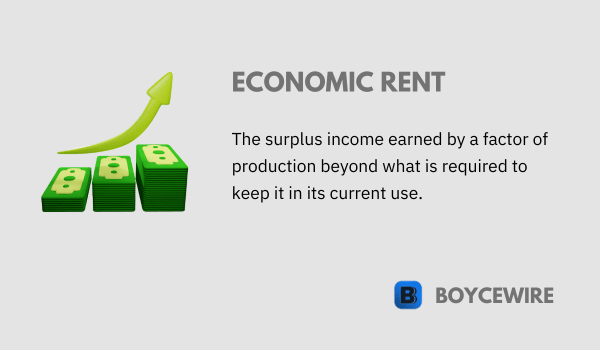Economic Rent: Definition, Formula & Examples

What is Economic Rent?
Economic rent is a fundamental concept that pervades various discussions in economics, from labor markets to natural resources, taxation to public policy. This term refers to the excess payments made over what is required to keep a factor of production—such as land, labor, or capital—in its present use. In other words, economic rent is the surplus earned above the normal expected return on an investment or employment.
The understanding of economic rent is crucial in examining market efficiency, analyzing different economic systems, and devising government policies. Furthermore, this concept helps in assessing how market conditions, supply and demand dynamics, and regulatory frameworks can shape the profitability and performance of various economic activities.
Key Points
- Economic rent refers to the surplus income earned by a factor of production beyond what is required to maintain its current use.
- Factors with limited availability or high demand, such as prime real estate locations or specialized skills, are more likely to generate economic rent.
- It often arises from factors that possess unique qualities that set them apart in the market.
Understanding Economic Rent
Economic rent, in its most basic form, is an economic concept that defines the surplus or excess payment made for a good or service over and above the minimum necessary amount to bring that good or service to market. This minimum necessary amount is often referred to as opportunity cost, which is the cost of the next best alternative foregone.
It can apply to any factor of production including labor, land, and capital, but it’s often associated with payments for land and other natural resources. For example, if a piece of land could be rented out for $10,000 per month for farming, but could also be rented out for $12,000 per month for building a shopping center, the economic rent is the difference between the two, or $2,000.
In an ideal, fully competitive market, the absence of excess income would prevail, given that competition would regulate prices to align with production expenses (including the regular profit necessary for maintaining resource use). Nonetheless, actual markets deviate from perfect competition, and several variables can lead to the emergence of surplus earnings. Such circumstances encompass monopolies or monopsonies, limitations on supply, and demand that’s relatively unresponsive to changes in price.
Understanding this concept is crucial to many areas of economics, including the study of market structures, factor markets, income distribution, and the design of taxes and subsidies. It is a fundamental concept in the field of economics that helps in the understanding of the economic principles governing resource allocation and income distribution.
Factors Influencing Economic Rent
Economic rent can be influenced by various factors. Understanding these factors can provide a better comprehension of how it varies across different sectors, regions, or times. Below are some of the significant influencing factors:
- Scarcity The level of scarcity of a resource directly impacts its economic rent. If a resource is scarce, its economic rent will be high because there’s a high demand but low supply.
- Productivity of the Resource If a resource can produce more output, its economic rent is likely to be higher. This is particularly true for land and labor, where fertility of land or the skills of a worker can significantly influence productivity.
- Demand for the Resource If the demand for a good, service, or resource is high, this can drive up its economic rent. For instance, in areas with high demand for housing but limited land, the economic rent for landowners can be very high.
- Supply of Alternatives The more alternatives to a resource that exist, the lower its economic rent. If there are many alternative resources that can serve the same purpose, the demand for a specific resource will decrease, reducing its economic rent.
- Legal or Institutional Factors Laws or institutions that restrict competition can lead to higher economic rents. For example, monopolies or patented technologies can command high economic rents because they face no competition.
- Technological Changes Technological improvements can affect the productivity of a resource, influencing its economic rent. For instance, innovations in agricultural technology can increase land productivity, thereby increasing its economic rent.
- Speculative Expectations Sometimes, the expectation of an increase in price or future scarcity of a resource can lead to an increase in economic rent in the present.
By comprehending these factors, economists and policymakers can have a better understanding of income distribution and can design appropriate economic policies, such as taxes and subsidies, to control excessive economic rent and ensure a fair distribution of resources and wealth.
Economic Efficiency of Economic Rent
Economic rent plays a crucial role in achieving economic efficiency. It is a concept that describes how effectively economic resources are allocated in an economy. When markets are operating at their most efficient, resources are allocated to their most valuable uses, and all opportunities for improving social welfare have been utilized.
- Incentive for Resource Allocation It provides incentives for resources to be allocated according to their most efficient use. For instance, higher rent for a piece of land in an urban area motivates its use for a shopping mall or apartment complex rather than farming.
- Encourages Innovation and Competition It encourages innovation and competition among firms. Firms are motivated to innovate to earn abnormal profits, i.e., economic rent, which is above their normal expected profit. This fosters competition among businesses and pushes them to use resources efficiently.
- Rewarding Scarce ResourcesIt serves as a mechanism to reward owners of scarce resources. It provides the incentive for these resource owners to make their resources available in the market.
- Influence on Production Decisions It can influence production decisions. Businesses will produce more of the goods that generate the highest economic rent and fewer of those that generate less . This leads to an efficient allocation of resources in response to consumer demand.
- Impact on Social Welfare If properly managed, it can be used to enhance social welfare. The government can tax it, particularly those earned by natural resources or monopoly power, and redistribute this income to enhance social welfare.
However, it’s important to note that while economic rent can contribute to economic efficiency, it can also lead to inefficiency if it results from market imperfections such as monopoly power or government policies that distort market conditions. Therefore, understanding it and its implications is crucial for policy-making aimed at enhancing economic efficiency.
Economic Rent in Different Economic Systems
Economic efficiency refers to the optimal production and consumption of goods and services. This optimal allocation ensures that the needs and wants of consumers are met, and resources are not wasted. Economic rent, which refers to the surplus value after all costs and normal returns have been accounted for, can be a useful tool in understanding how economic efficiency operates in different economic systems:
- Capitalist Economies In capitalist systems, economic efficiency is largely driven by market forces of supply and demand. Economic rent plays a significant role in such economies as high rents act as a signal to the market that there is a high demand for certain goods or services, leading to more resources being allocated to produce those goods or services. However, it can also lead to inequality in capitalist societies, as those who own scarce resources can command high rents.
- Socialist Economies In socialist systems, economic efficiency is dictated by the state or government, with the goal of equal distribution of resources among all citizens. Here, the concept of economic rent is often controlled or mitigated by the government to prevent any individual or group from earning significantly more than others. This is done through measures such as rent control or taxation.
- Mixed Economies Mixed economies combine elements of both capitalist and socialist systems. In these economies, economic rent can exist, but it is often regulated by the government to prevent exploitation and maintain economic balance. Economic efficiency in mixed economies is achieved through a combination of market mechanisms and state intervention.
In summary, the role and influence of economic rent on economic efficiency can vary greatly depending on the economic system in place. Understanding this can help in forming policies and strategies for achieving economic efficiency and fairness.
Applications of Economic Rent
- Resource Allocation Economic rent can be used as a tool to better understand the allocation of resources in a given market. High rents signal that there is a high demand for a certain good, leading to more resources being allocated to produce those goods or services.
- Pricing Strategies In sectors where certain resources are more scarce than others, businesses can adjust their pricing strategies based on the concept. They might increase the prices of their goods or services to generate a higher rent.
- Policy Making Understanding this concept is vital for policymakers, especially those involved in taxation and public services. Governments can impose taxes to redistribute wealth and reduce social inequalities.
- Investment Decisions Investors can use the concept to identify profitable opportunities. If a company has a high economic rent, it might indicate that it has a competitive advantage, such as a unique resource that others do not have access to.
- Labour Market Analysis Economic rent can also be applied to labor markets to understand wage differences. For example, a worker’s wage in excess of the minimum wage that the worker would accept is considered the worker’s rent. This concept can be useful in understanding the implications of wage negotiations and labor union activities.
- Real Estate The concept is also significant in the real estate sector. It helps in understanding the price variations in different locations. Properties in prime locations command a higher rent due to the high demand and limited supply of such properties.
In each of these applications, economic rent provides valuable insight into market dynamics, enabling better decision-making for businesses, investors, and policy makers.
Limitations of Economic Rent
- Over-Simplification The concept of economic rent often assumes a perfectly competitive market, which rarely exists in reality. Therefore, the implications drawn might not accurately represent the complex dynamics of a real-world market.
- Static Analysis Economic rent is often analyzed at a specific point in time. However, markets are dynamic and influencing factors such as supply, demand, and competition, change over time. This dynamic aspect is not usually captured.
- Influence of External Factors The concept does not take into account external influences such as government regulations, changes in consumer preferences, and technological advancements, which can significantly impact market dynamics.
- Income Inequality Economic rent can contribute to income inequality. Those who control unique and scarce resources can generate significant rents, creating wealth disparity.
- Difficulty in Measurement It’s difficult to measure precisely because it’s challenging to determine the opportunity cost for resources, especially when those resources have multiple alternative uses.
- Rent-Seeking Behavior The possibility of earning income can encourage rent-seeking behavior, where individuals or firms attempt to gain wealth without creating new wealth, often through manipulation of the economic environment rather than through trade and production of new goods and services. This can lead to inefficiency and misallocation of resources.
Despite these limitations and criticisms, it remains a valuable concept in understanding market dynamics and resource allocation. However, it should be used cautiously and in conjunction with other economic models to get a more accurate representation of economic realities.
Examples of Economic Rent
- Land Ownership The most classical example of economic rent comes from land ownership. When a piece of land is rented out, the rent is often more than the income needed to induce the landowner to rent the land. The excess is the economic rent, which is usually determined by factors like location, fertility (for agricultural land), or any unique attributes that the land might have.
- Celebrities and Athletes Famous celebrities and professional athletes often earn much more than what would be required to induce them to perform their work. The excess income they receive, which can be attributed to their unique skills, talents, or fame, is considered economic rent.
- Patents and Copyrights Companies or individuals that own patents or copyrights often receive economic rent. For instance, a pharmaceutical company that holds a patent for a specific drug can sell the drug at a price higher than the cost of production, thus earning an income.
- Resource-Rich Countries Countries rich in natural resources like oil, minerals, or rare earth elements often earn economic rent by exporting these scarce resources. The revenue generated is often significantly higher than the cost of extraction and supply.
- Monopolies Firms with monopoly power can set prices above marginal cost, thereby earning an economic rent. This is possible due to lack of competition and the unique product or service that the firm provides.
- Economic Rent in the Job Market In certain professions, workers earn more than the minimum wage they would be willing to work for. This could be due to factors such as experience, unique skills, or high demand for that profession.
These examples illustrate how economic rent occurs in various scenarios. However, the concept is not without controversy and is often associated with income inequality and other economic and social issues.
FAQs
Economic rent is the surplus income earned by a factor of production, such as land, labor, or capital, beyond what is required to keep it engaged in its current use.
Economic rent represents income beyond what is necessary for a factor’s utilization, while normal profit covers the cost of production and compensates entrepreneurs for their time and effort.
Factors that are scarce, in high demand, or possess unique qualities, such as prime real estate locations or specialized skills, are more likely to generate economic rent.
No, economic rent specifically refers to surplus income from factors of production, while economic profit considers the total surplus gained from a business venture after accounting for all costs, including normal profit.
About Paul
Paul Boyce is an economics editor with over 10 years experience in the industry. Currently working as a consultant within the financial services sector, Paul is the CEO and chief editor of BoyceWire. He has written publications for FEE, the Mises Institute, and many others.

Further Reading
 Ceteris Paribus: Definition, Pros, Cons & Examples - Ceteris Paribus is a phrase used in economics that makes economic analysis simpler.
Ceteris Paribus: Definition, Pros, Cons & Examples - Ceteris Paribus is a phrase used in economics that makes economic analysis simpler.  Free Market: Definition, Pros, Cons & Examples - A free market is where the people in an economy are free to engage in economic activities and transactions without…
Free Market: Definition, Pros, Cons & Examples - A free market is where the people in an economy are free to engage in economic activities and transactions without…  Consumer Surplus: Graph, Examples & How to Calculate - The consumer surplus is the difference between what the consumer is willing to pay, and what they actually pay.
Consumer Surplus: Graph, Examples & How to Calculate - The consumer surplus is the difference between what the consumer is willing to pay, and what they actually pay. 
